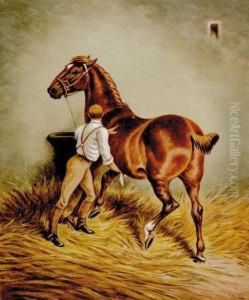William Telbin Paintings
William Telbin, born in 1813, was a distinguished British painter, best known for his work as a scene painter for theatres, particularly in the realm of pantomime and diorama. His career flourished during the Victorian era, a period that saw a burgeoning interest in theatrical arts and innovations in stagecraft. Telbin's contributions were pivotal in enhancing the visual spectacle of theatre, making him an influential figure in the evolution of scenic design.
Telbin's talent in creating immersive, detailed backdrops and scenes brought many stage productions to life. His ability to manipulate perspective and lighting allowed him to create illusions of depth and realism that were revolutionary for the time. He worked extensively for the Drury Lane Theatre, one of London's most famous venues, where his skills were showcased in numerous productions. Telbin's work was characterized by its meticulous attention to detail and vibrant use of color, which captivated audiences and transported them to other worlds, from fairy-tale landscapes to historical settings.
Throughout his career, William Telbin was instrumental in elevating the status of scene painting from mere backdrop creation to an art form in its own right. His legacy is not just in the scenes he created but also in his influence on subsequent generations of theatrical designers. He demonstrated the power of visual art to enhance narrative and emotion in storytelling, a principle that continues to underpin theatrical design today. Despite the lack of extensive personal documentation, Telbin's work survives through the productions he contributed to and the impact he had on the visual language of theatre. He passed away in 1873, leaving behind a body of work that continues to be studied and admired by art historians and theatre practitioners alike.
